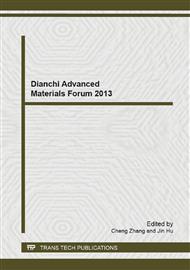p.326
p.330
p.335
p.339
p.343
p.349
p.355
p.360
p.365
Structural and Electrical Transport Properties of the Type-I Clathrate Phase Ba8Ga16InxGe30-x
Abstract:
Thermoelectric (TE) devices are increasingly being seen as having the potential to make important contributions to reducing greenhouse gas emissions and providing cleaner forms of energy. A number of articles have been devoted to the thermoelectric properties of materials. From the search for novel and effective thermoelectric materials the clathrate structures has emerged as one of the most promising candidates for achieving very high thermoelectric figure of merit: ZT= α2σT/κ, where α, T, σ and κ are the Seebeck coefficient, absolute temperature, electrical conductivity, and total thermal conductivity, respectively [1]. For the past decade, caged clathrate compounds of group IV elements have attracted much attention because they would possess a low kL value as the theoretical minimum one, which results from rattling of atoms filled in their cages [2-3]. There are the type-I, type-III, and type-VIII structures in thermoelectric clathrates, but most compounds adopt type-I structure (space group No.223; Pm-3n). A large number of the type-I clathrates with the chemical formula of II8III16IV30 (II=Ba, Sr, Eu, III=Al, Ga, In, and IV= Si, Ge, Sn) have been synthesized and studied intensively [5-11], which results in relatively high ZT values such as 0.7 at 700 K for Ba8Ga16Ge30 and 0.87 at 870 K for Ba8Ga16Si30 [3]. Among type-I clathrates, a single-crystal n-type Ba8Ga16Ge30 grown using the Czochralski method with a ZT of 1.35 at 900 K is one of the most promising results [12].
Info:
Periodical:
Pages:
343-348
Citation:
Online since:
November 2013
Authors:
Price:
Сopyright:
© 2014 Trans Tech Publications Ltd. All Rights Reserved
Share:
Citation:


